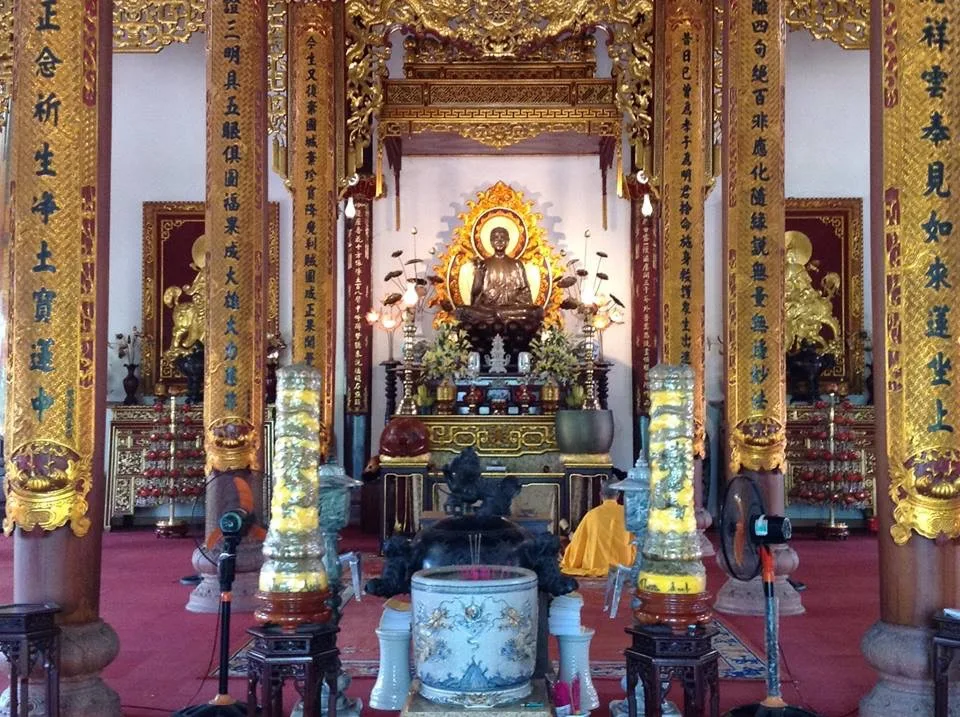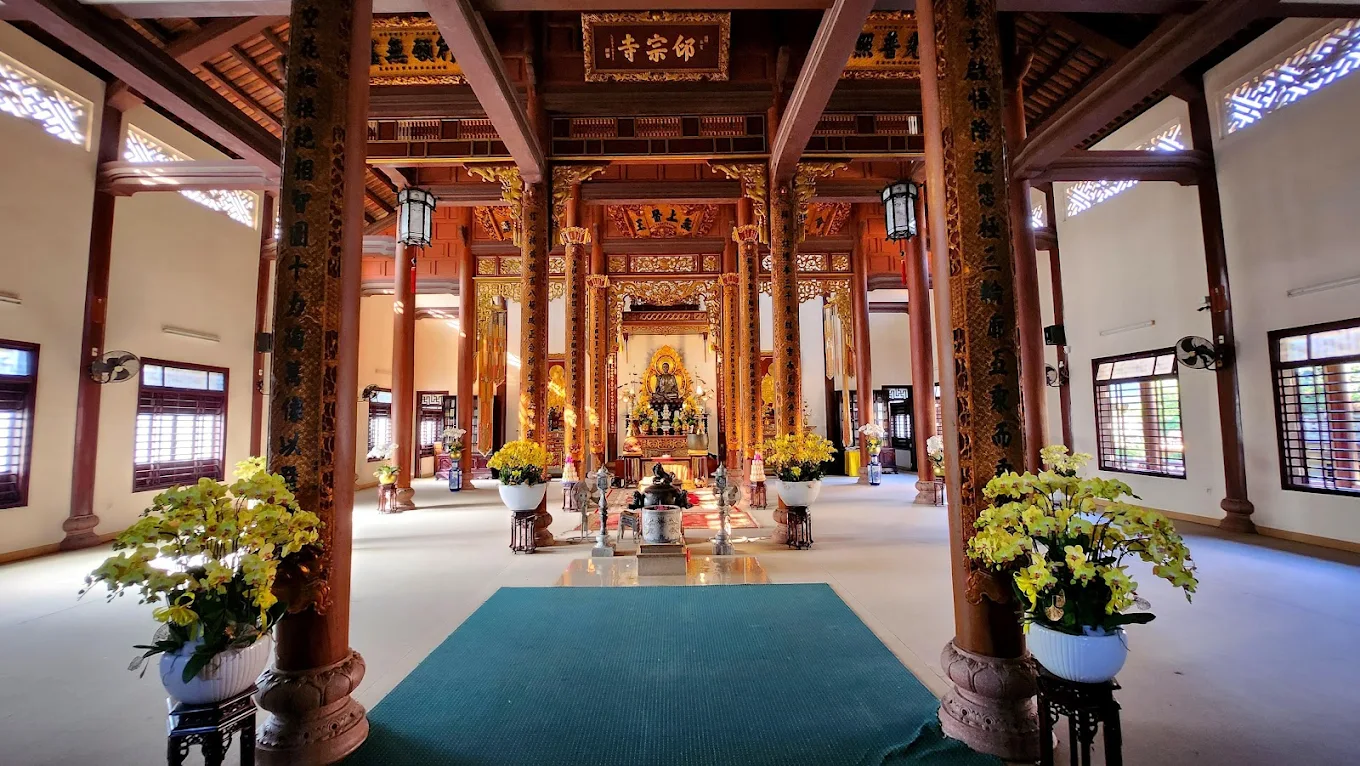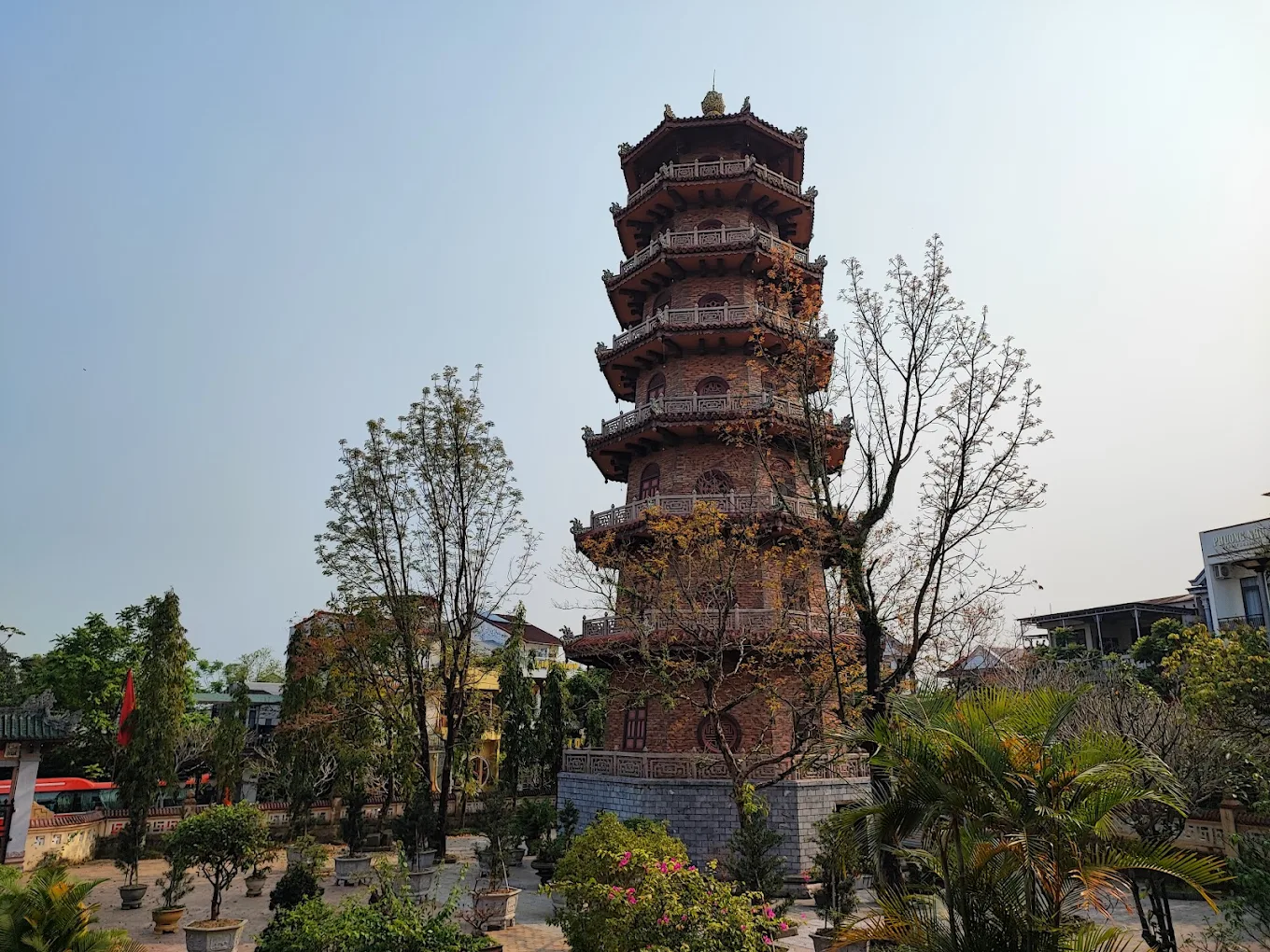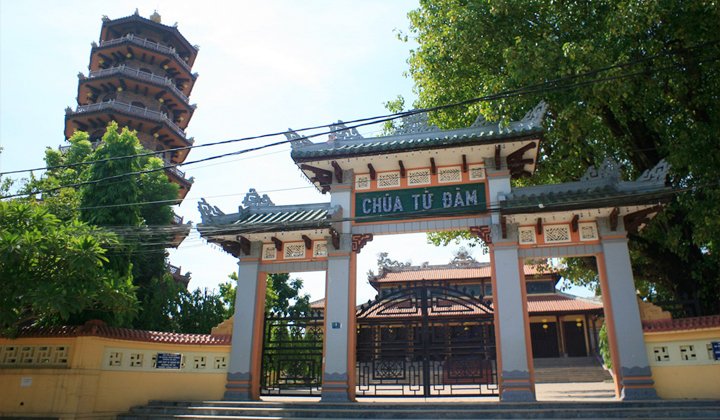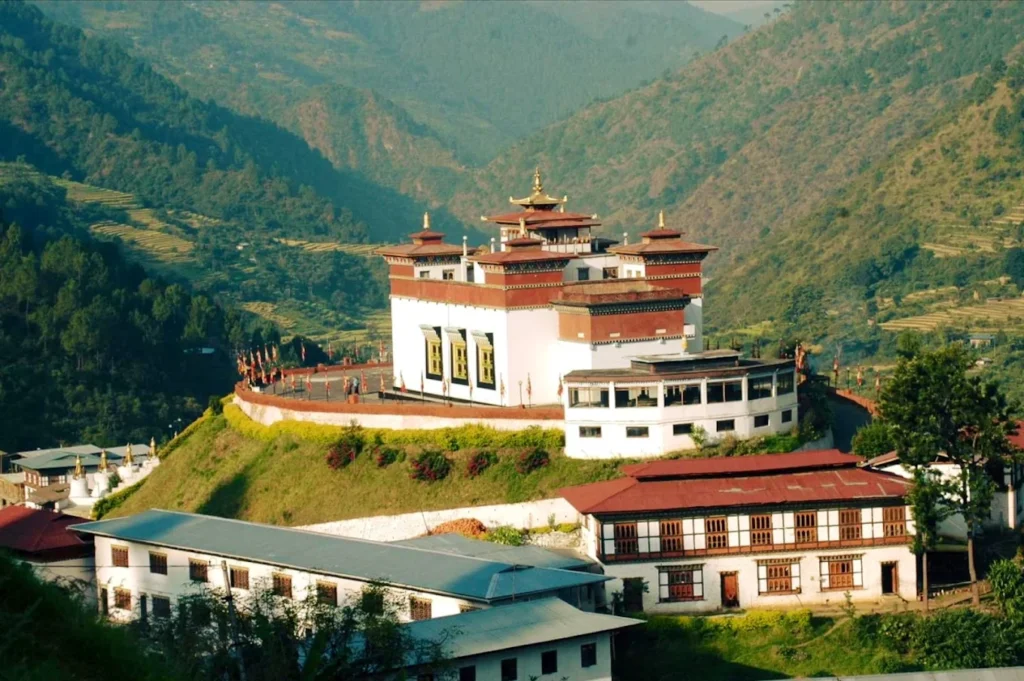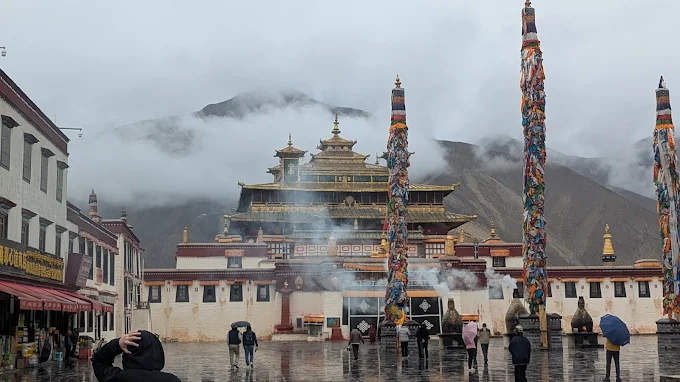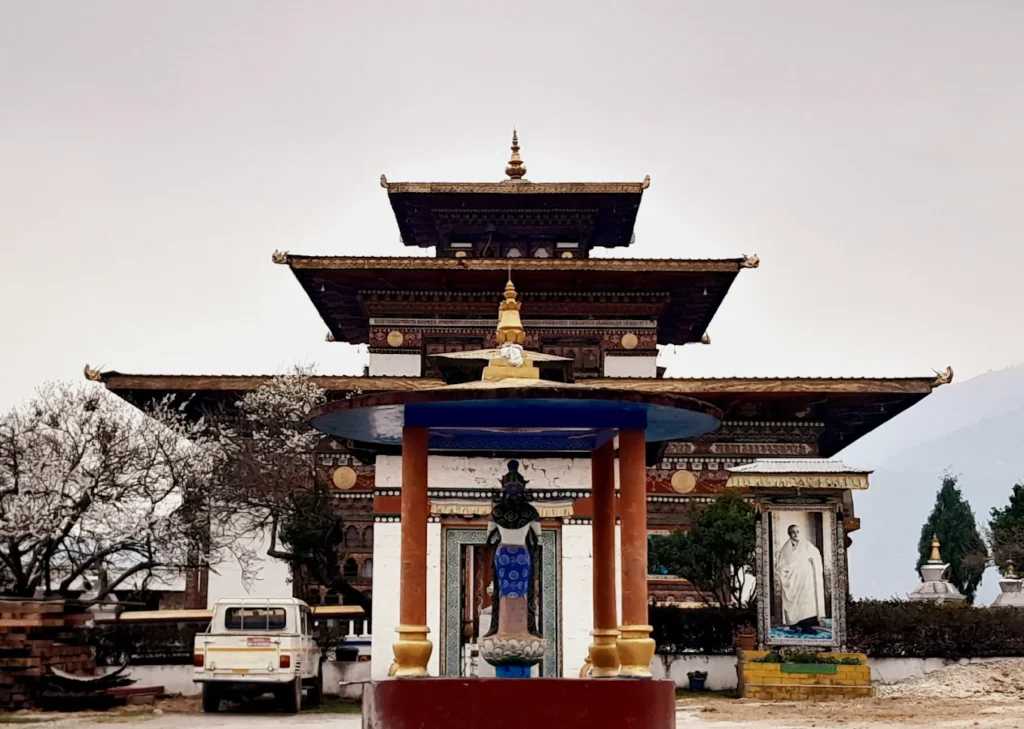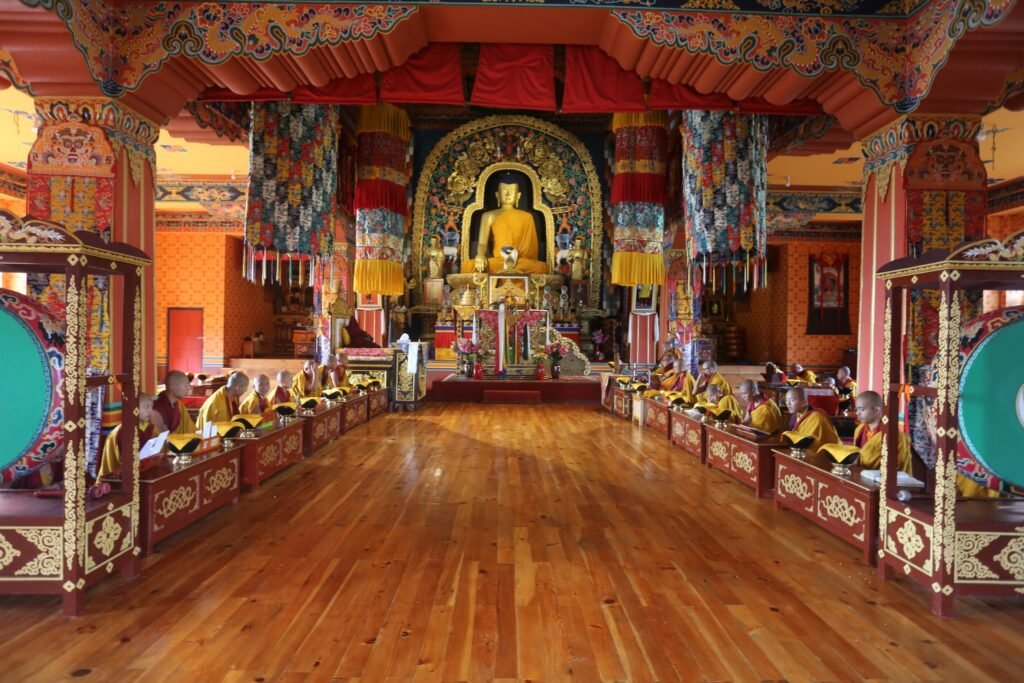Từ Đàm Pagoda: The Spiritual Beacon of Huế’s Buddhist Revival
In the heart of Huế’s Phường Trường An, where the scent of lotus incense drifts through morning mist, Từ Đàm Pagoda stands as a radiant pillar of Mahayana Buddhist devotion. In the main hall (chánh điện), monks chant the Lotus Sutra beneath a golden statue of Shakyamuni Buddha, their voices harmonizing with the rustle of a sacred Bodhi tree’s leaves. Founded in the late 17th century by Zen Master Minh Hoằng Tử Dung, this pagoda sparked Vietnam’s Buddhist revival, its serene grounds pulsing with spiritual renewal. Shaded by a towering Bodhi tree, a gift from India, the pagoda’s red-tiled roofs and Tam Quan gate evoke Huế’s timeless elegance. Each incense stick lit honors Shakyamuni, guiding devotees toward enlightenment. From its urban oasis, the nearby Sông Hương glimmers, tying the pagoda to Huế’s spiritual rhythm. This sacred haven invites travelers, seekers, and scholars to explore Vietnam’s Buddhist soul, a living testament to faith and resilience.
Whispers of Awakening: Overview and Significance
Introduction to Từ Đàm Pagoda
Từ Đàm Pagoda, nestled at 1 Sư Liễu Quán in Huế’s Phường Trường An, is a revered Mahayana Buddhist sanctuary, renowned as a cradle of Vietnam’s Buddhist revival and home to a sacred Bodhi tree from India. Its tranquil grounds, blending traditional architecture with modern elements, offer a retreat from Huế’s urban pulse, drawing pilgrims and cultural explorers. Named “Từ Đàm” (Compassionate Cloud), it reflects Mahayana’s call to compassion and wisdom, shaped by Zen Master Minh Hoằng Tử Dung and later Venerable Thích Tịnh Khiết. A spiritual and historical beacon, the pagoda embodies Huế’s Buddhist legacy, uniting past and present in serene devotion.
Historical Journey
Từ Đàm Pagoda traces its origins to 1695, when Zen Master Minh Hoằng Tử Dung, a Chinese monk, founded it as a modest meditation hermitage. By the 18th century, it grew into a major Buddhist center under Nguyễn Dynasty patronage, its Tam Quan gate added in 1840. In the 1930s, under Venerable Thích Tịnh Khiết, it became a hub for the Buddhist revival, establishing the Vietnam Buddhist Sangha. A 1966 reconstruction modernized its structures, cementing its role as a national spiritual landmark, enduring through wars and cultural shifts.
Cultural Resonance
- Mahayana Devotion: Rooted in Mahayana Buddhism, the pagoda centers on Shakyamuni and Avalokitesvara, guiding devotees toward enlightenment.
- Ethnic Vietnamese Heritage: A spiritual anchor for the Kinh community, it preserves rituals like sutra chanting and vegetarian feasts.
- Buddhist Revival: Its 1930s role in unifying Vietnamese Buddhism marks it as a national cultural pillar.
- Regional Influence: Festivals draw Buddhists from Thừa Thiên Huế and beyond, fostering spiritual unity.
Unique Legacy
- Bodhi Tree: Planted in 1936, this sacred tree, a gift from India, symbolizes enlightenment, its leaves shading meditative spaces.
- Revival Hub: The pagoda’s leadership in the Buddhist revival shaped modern Vietnamese Buddhism.
- Urban Serenity: Its tranquil grounds offer a rare calm amid Huế’s cityscape.
- Enduring Symbol: Its resilience through history reflects Vietnam’s Buddhist spirit.
Community and Global Impact
- Local Devotion: The pagoda hosts festivals and retreats, strengthening Kinh Buddhist bonds.
- Pilgrimage Hub: Thousands visit annually, drawn by its spiritual and historical significance.
- Global Appeal: International Buddhists and tourists seek its revival legacy and serene ambiance.
- Cultural Dialogue: Shared rituals unite local and global visitors, fostering cross-cultural understanding.
Modern Relevance
- Spiritual Retreat: In a fast-paced world, Từ Đàm Pagoda offers a haven for mindfulness.
- Cultural Preservation: It safeguards Mahayana practices, ensuring Huế’s Buddhist heritage thrives.
- Educational Role: As a Sangha hub, it trains monks and educates laypeople.
Historical Anecdotes
- Revival Spark: The 1930s movement here unified Buddhist sects, shaping Vietnam’s spiritual landscape.
- Royal Patronage: Nguyễn emperors supported its growth, embedding it in Huế’s history.
- 1963 Protests: Monks here led Buddhist activism, influencing national history.
Social Role
- Community Hub: Festivals and teachings unite Kinh Buddhists.
- Educational Center: Monks train novices and teach Buddhist principles.
- Charitable Spirit: Vegetarian feasts reflect Mahayana’s generosity.
Artistic Influence
- Poetic Inspiration: The Bodhi tree and Tam Quan gate inspire Huế’s poets and artists.
- Cultural Icon: The pagoda’s architecture graces local artworks, symbolizing spiritual renewal.
- Festival Art: Lotus lanterns and ceremonial decorations showcase Kinh craftsmanship.
Crafted by Compassion: Architectural and Spiritual Features
Iconic Design
Từ Đàm Pagoda’s architecture blends Vietnamese Mahayana elegance with modern simplicity, creating a serene urban oasis. Red-tiled roofs and whitewashed walls, adorned with lotus motifs, harmonize with the surrounding gardens. The layout, centered on the main hall, follows Buddhist principles of balance, with the Bodhi tree as a spiritual focal point. Its central Huế location, near the Sông Hương, infuses meditative calm, blending tradition with the city’s pulse.
Key Structures
- Main Hall (Chánh Điện): The spiritual core, with wooden beams and lotus carvings, houses the Shakyamuni statue.
- Tam Quan Gate: A grand entrance, built in 1840, with dragon reliefs, welcomes pilgrims.
- Bodhi Tree Courtyard: A shaded space for meditation, centered on the 1936 Bodhi tree.
- Meditation Hall: A quiet space for silent practice, open to monks and visitors.
- Bell Tower: A stone structure with a bronze bell, rung during ceremonies, resonates softly.
- Library Pavilion: A modern addition for Buddhist texts, fostering study.
- Monastic Quarters: Modest buildings for monks, blending with the gardens.
- Garden Shrine: A small altar for Avalokitesvara, nestled among lotuses.
Worshipped Statues
- Shakyamuni Buddha: A golden statue in the main hall, depicting meditation, symbolizes enlightenment.
- Avalokitesvara (Quan Thế Âm): A white jade statue, holding a nectar vase, radiates compassion.
- Amitabha Buddha: A bronze statue, symbolizing rebirth in the Pure Land, flanks the altar.
- Spiritual Role: Devotees offer incense to Shakyamuni and Avalokitesvara, seeking wisdom and compassion.
Materials and Techniques
- Construction: Local brick and teak, joined with Vietnamese techniques, ensure durability.
- Artistry: Lotus carvings and ceramic tiles, crafted by Kinh artisans, reflect Buddhist symbolism.
- Cultural Essence: The design blends Mahayana simplicity with Huế’s imperial aesthetic.
Signature Elements
- Bodhi Tree: The 1936 tree, a gift from India, anchors the pagoda’s spiritual mission.
- Tam Quan Gate: Its ornate design symbolizes entry into sacred space.
- Riverside Proximity: Near the Sông Hương, it ties spirituality to Huế’s landscape.
Lesser-Known Features
- Stone Inscriptions: Tablets near the courtyard bear 18th-century prayers.
- Hidden Shrine: An alcove for Patriarch Liễu Quán hosts special rituals.
- Vintage Bell: A 19th-century bell carries a soft, resonant tone.
Preservation Efforts
- Restoration (1966): Reconstruction preserved traditional elements while modernizing.
- Challenges: Urban humidity erodes brickwork, requiring regular upkeep.
- Modern Additions: Solar lanterns, added in 2023, light the grounds.
Environmental Integration
- Garden Harmony: The Bodhi tree and lotus ponds preserve the ecosystem.
- Eco-Practices: Monks promote tree planting, reflecting Buddhist ethics.
- Wildlife Haven: Gardens shelter birds, enhancing meditative ambiance.
Artisan Narratives
- Gate Builders: 19th-century Huế artisans crafted the Tam Quan gate’s dragon reliefs.
- Tile Makers: Ceramic tiles, fired in local kilns, bear lotus patterns.
- Tree Caretakers: Monks tend the Bodhi tree, a generational labor.
Symbolic Details
- Bodhi Tree: Represents enlightenment, its leaves symbolizing wisdom.
- Lotus Motifs: Signify purity rising above suffering.
- Red Tiles: Evoke vitality and spiritual protection.
Landscape Integration
- Urban Oasis: The pagoda’s gardens contrast Huế’s cityscape, fostering calm.
- River Proximity: The Sông Hương enhances meditative reflection.
- Garden Paths: Winding trails encourage mindful walking.
Rites of the Heart: Rituals and Practices
Daily Sacred Rites
- Morning Chanting: Monks recite the Lotus Sutra at dawn, fostering mindfulness.
- Meditation Sessions: Silent meditation, held twice daily, centers on compassion.
- Incense Offerings: Devotees light lotus-scented incense before Shakyamuni.
Unique Practices
- Pure Land Chanting: Devotees recite Amitabha’s name, seeking rebirth, a Mahayana ritual.
- Vegetarian Feasts: Monthly lunar gatherings offer communal meals, symbolizing non-violence.
- Signature Ritual: Offering lotus flowers to Avalokitesvara, tied to the pagoda’s compassion focus.
Festival Traditions
- Buddha’s Birthday (8th day, 4th lunar month): Lantern processions and statue bathing draw crowds.
- Ullambana Festival: Candle-lit offerings honor ancestors, uniting families.
- Avalokitesvara’s Birthday: Flower processions celebrate compassion, with statues adorned in silk.
- Statue Veneration: Shakyamuni and Avalokitesvara are draped in robes during festivals.
Visitor Engagement
- Accessible Rituals: Visitors can join chants or offer incense, guided by monks.
- Offerings: Flowers and incense, available at the shop, invite participation.
- Buddhist Etiquette: Bow three times before statues, signaling respect.
Spiritual Community Roles
- Monastics: Monks lead rituals and train novices, guiding the community.
- Lay Devotees: Kinh volunteers organize festivals and maintain grounds.
- Statue Care: Daily cleaning of statues reflects devotion.
Interfaith Connections
- Syncretic Practices: Some blend Buddhist prayers with folk beliefs, offering fruit.
- Outreach: Festivals host interfaith dialogues, welcoming diverse perspectives.
- Education: Monks teach Mahayana principles to visitors.
Ritual Symbolism
- Lotus Offerings: Lotuses mirror purity transcending suffering.
- Incense Smoke: Spirals symbolize prayers reaching the divine.
- Chanting Rhythm: The Lotus Sutra aligns mind and spirit.
Seasonal Variations
- Spring Festivals: Vibrant with lotuses, ideal for Buddha’s Birthday.
- Autumn Rites: Cooler weather enhances calm during Ullambana.
- Monsoon Season: Chants under rain offer unique serenity.
Monastic Life
- Daily Routine: Monks rise at dawn for chants, meditation, and study.
- Community Service: Monks guide lay devotees in rituals and teachings.
- Training Hub: The pagoda trains monks for the Vietnam Buddhist Sangha.
Journey to Tranquility: Visitor Information
Navigating to Từ Đàm Pagoda
- Location: 1 Sư Liễu Quán, Phường Trường An, Huế City, Thừa Thiên Huế Province, central Huế.
- Landmarks: Near An Cựu Bridge and the Sông Hương, with clear Vietnamese and English signs.
- Routes: Accessible by taxi, motorbike, or bicycle from Huế’s center.
Address of Từ Đàm Pagoda
- Vietnamese: Chùa Từ Đàm, 1 Sư Liễu Quán, Phường Trường An, Thành phố Huế, Tỉnh Thừa Thiên Huế.
- English: Từ Đàm Pagoda, 1 Sư Liễu Quán Street, Trường An Ward, Huế City, Thừa Thiên Huế Province.
Visiting Hours and Etiquette
- Hours: Open daily, 6:00 AM–5:00 PM, with extended festival hours.
- Etiquette: Remove shoes before the main hall, speak softly, and dress modestly.
- Mahayana Custom: Offer incense with both hands and bow to statues.
Transport Options
- By Taxi: A reliable choice from Huế’s center, with drop-off near the gate.
- By Motorbike: Offers flexibility to explore nearby sites.
- By Bicycle: A scenic ride suits active visitors.
Accessibility and Safety
- Mobility: Flat grounds are accessible; some areas may challenge mobility issues.
- Safety: Well-maintained paths and monastic presence ensure security.
- Tips: Wear comfortable shoes for garden paths.
Amenities and Surroundings
- Facilities: Restrooms and a shop offer incense, flowers, and Buddhist texts.
- Nearby: An Cựu Bridge and Thiên Mụ Pagoda, within 3 km, offer cultural experiences.
- Dining: Vegetarian stalls nearby serve mindful meals.
Immersive Visitor Tips
- Best Timing: Dawn visits offer serene chants and cooler temperatures.
- Sensory Moments: Inhale lotus incense and hear the Bodhi tree’s leaves.
- Statue Connection: Offer flowers to Avalokitesvara and meditate briefly.
- Festival Planning: Attend Buddha’s Birthday for vibrant processions.
Nearby Cultural Experiences
- An Cựu Bridge: Explore Huế’s historic architecture, 1 km away.
- Sông Hương: Boat trips offer scenic views, enhancing the visit.
- Imperial Citadel: A 2-km ride reveals Huế’s royal history.
Photography Tips
- Best Angles: Capture the Bodhi tree at dawn for soft light.
- Respectful Shots: Avoid photographing monks during prayers without permission.
- Scenic Views: The courtyard offers stunning shots of the Tam Quan gate.
- Equipment: A smartphone or lightweight camera suffices.
Deepening the Experience: Cultural and Spiritual Insights
Mahayana Philosophy
Từ Đàm Pagoda embodies Mahayana’s core: compassion and wisdom as paths to enlightenment. Shakyamuni and Avalokitesvara inspire kindness, reflected in vegetarian feasts. “Emptiness” underscores interconnectedness, encouraging release of ego.
Environmental Spirituality
The Bodhi tree ties the pagoda to Buddhist enlightenment, its shade fostering meditation. Proximity to the Sông Hương enhances spiritual reflection, with chants blending into the river’s flow, deepening connection.
Artistic Symbolism
Lotus motifs signify purity, while the Bodhi tree represents wisdom. The Tam Quan gate’s dragon reliefs evoke divine protection. These elements invite contemplation of resilience and compassion.
Community Resilience
The pagoda reflects Kinh perseverance, rebuilt through community efforts. Its role in the Buddhist revival showcases collective faith, sustained by volunteer-led festivals.
Environmental Stewardship
The Bodhi tree and lotus ponds foster Buddhist environmental ethics. Tree-planting initiatives enhance the ecosystem. Visitors are urged to honor nature’s sanctity.
Meditative Practices
Mahayana meditation visualizes Avalokitesvara’s compassion. The meditation hall offers a quiet space for inner peace, amplified by the pagoda’s calm.
Cultural Narratives
- Revival Legacy: The 1930s movement unified Buddhist sects, shaping history.
- Monastic Tales: Monks share stories of Zen Master Minh Hoằng Tử Dung.
- Festival Lore: Buddha’s Birthday chants carry centuries-old traditions.
Historical Context
- Buddhist Revival: The pagoda’s 1930s leadership shaped modern Buddhism.
- Nguyễn Dynasty: Royal support embedded it in Huế’s history.
- 1963 Protests: Monks influenced Vietnam’s spiritual activism.
Reflecting on the Journey
Từ Đàm Pagoda is a sanctuary where compassion meets wisdom beneath the Bodhi tree’s shade. Its Tam Quan gate and golden statues embody Huế’s Buddhist soul, inviting all to seek enlightenment. The pagoda’s grounds, pulsing with revivalist spirit, tell a story of resilience and unity, rooted in Vietnam’s Mahayana heritage. Whether meditating before Shakyamuni, listening to the Sông Hương’s flow, or tracing the Buddhist revival’s legacy, visitors find a space to reflect and reconnect. As you leave, the lotus incense and rustling leaves linger, a reminder that awakening is always within reach.
